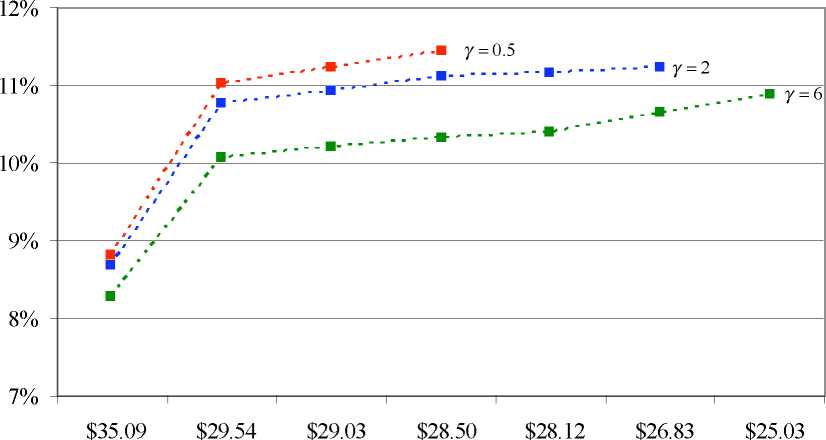Current Agriculture, Food & Resource Issues
M. Doyon, C. Brodeur and J-P. Gervais

Figure 1 Maximum discount rate of production quotas that entails no participation in the IEM
program for deliveries in May 2001 when average variable costs are $20 per hl.
utility line has an intuitive justification.4 The maximum discount rate of the quota must be
inversely proportional to export prices to guarantee that a producer will not participate in
the commercial export milk program. Thus, the iso-utility lines generated by the model
yield discount rates for dairy trade models that are a function of cost efficiency and
degrees of risk aversion.
Consider next the case in which producers have risk preferences that yield a CRRA
coefficient of 0.5. In terms of risk aversion, the current hypothetical producer is less risk
averse than when γ = 2, and thus willing to pay a lesser amount to avoid the risks
associated with dairy quota transactions. If the producer is offered an export contract of
$35.09 per hl, the maximum value of the discount rate is higher (8.8 percent) than when
the producer is less risk averse, ceteris paribus. The smaller degree of risk aversion
implies that a producer will not dislike variability in the domestic price of milk and the
price of the production quota for domestic deliveries as much as another producer with a
larger relative risk aversion coefficient. Thus, participation in the IEM program will
necessitate a higher discount rate. The differences between the maximum values of
discount rates given export prices are not especially large or important when comparing
values for γ of 0.5 and 2. These differences tend to be heightened when a producer
possesses a high coefficient of relative risk aversion ( γ = 6 ).
Note that an estimate of the maximum discount rate is not available when a producer
is offered an export contract worth less than $28.50 per hl and γ = 0.5. This is explained
by the fact that the expected utility function becomes linear in the decision variable as γ
tends to zero. Moreover, the net return on the risk-free asset, defined as the difference
125
More intriguing information
1. Knowledge and Learning in Complex Urban Renewal Projects; Towards a Process Design2. The name is absent
3. The name is absent
4. The name is absent
5. AN EXPLORATION OF THE NEED FOR AND COST OF SELECTED TRADE FACILITATION MEASURES IN ASIA AND THE PACIFIC IN THE CONTEXT OF THE WTO NEGOTIATIONS
6. The name is absent
7. The name is absent
8. Determinants of Household Health Expenditure: Case of Urban Orissa
9. Estimation of marginal abatement costs for undesirable outputs in India's power generation sector: An output distance function approach.
10. The Response of Ethiopian Grain Markets to Liberalization